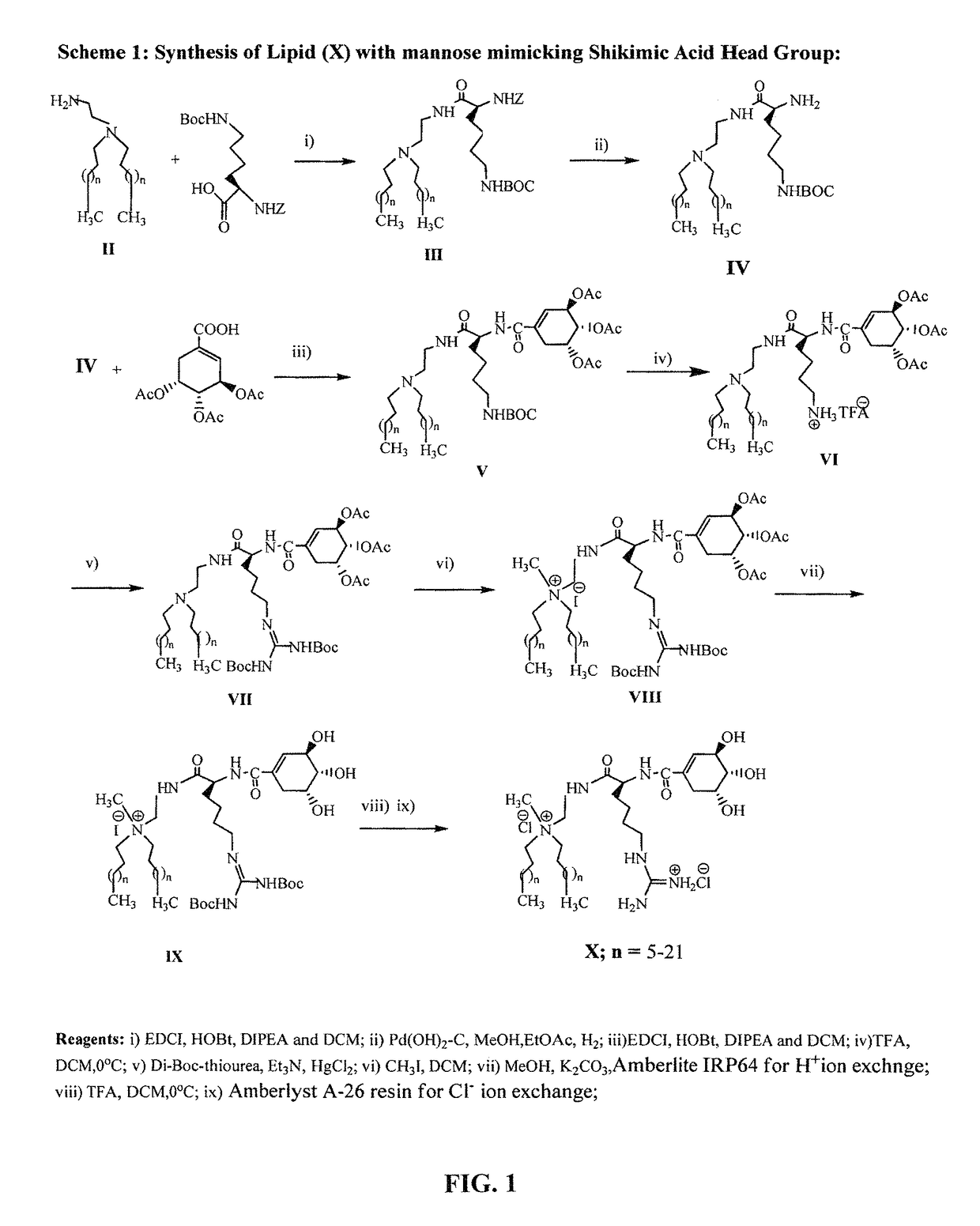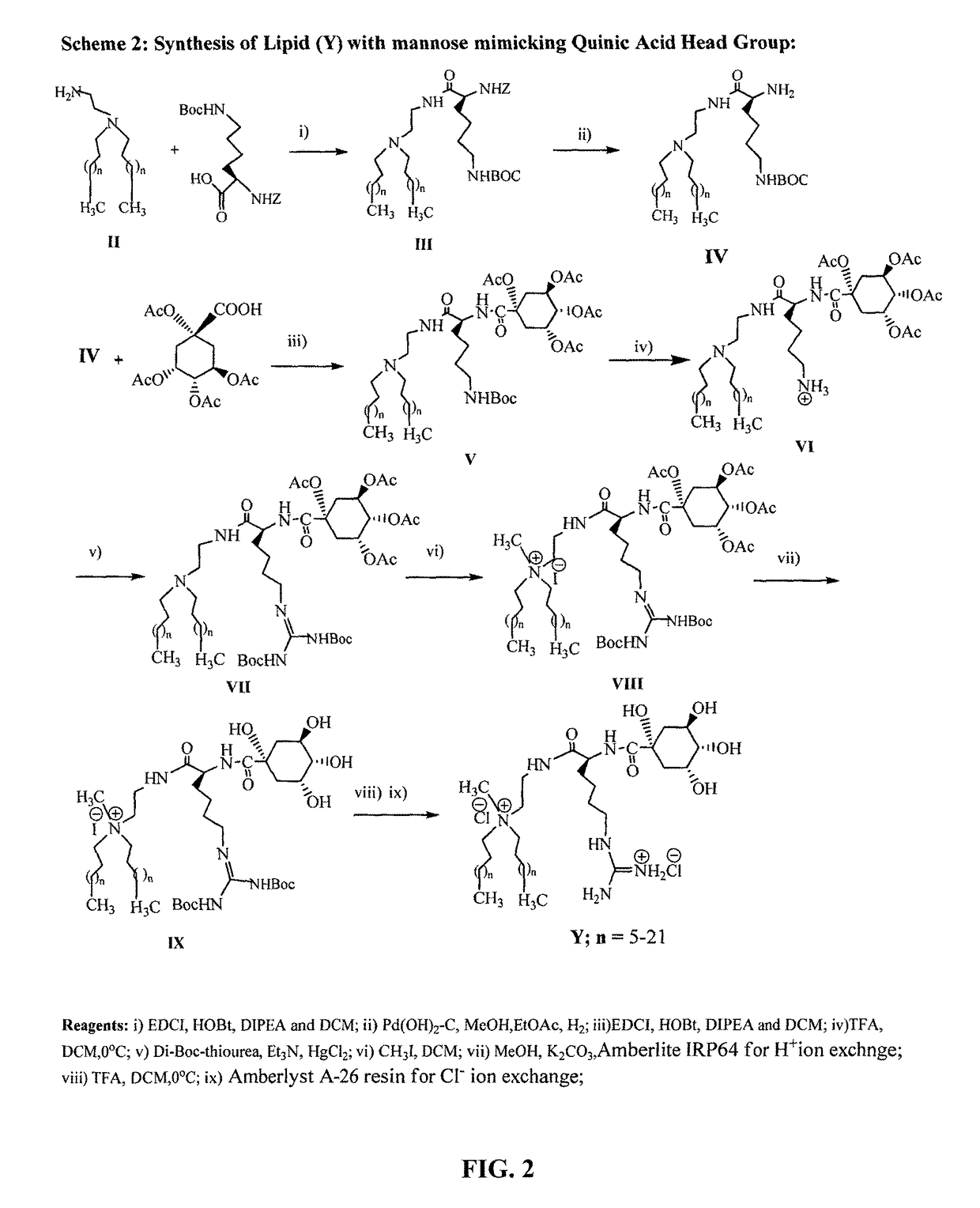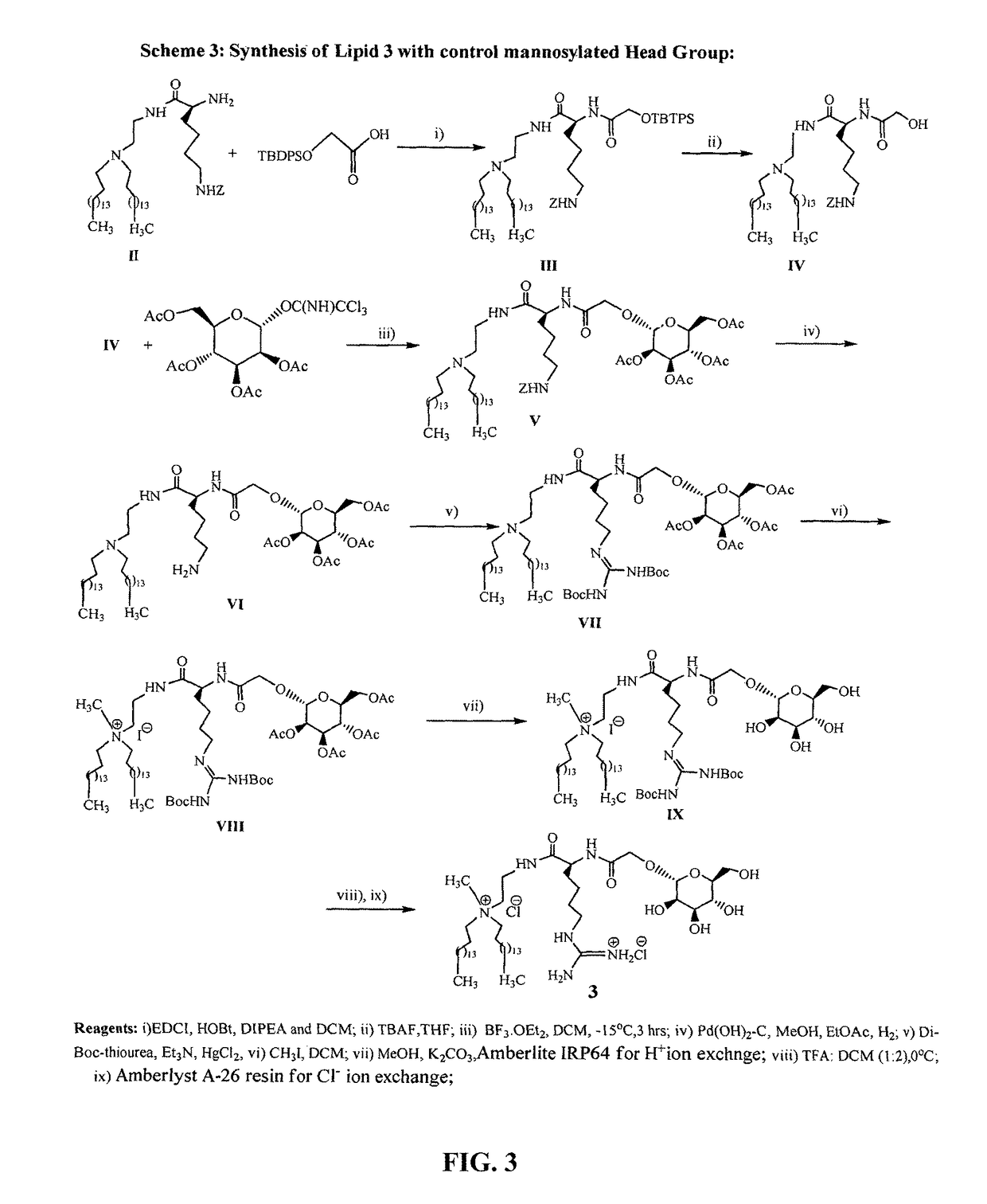Mannose-receptor selective lysinylated cationic amphiphiles and a process for preparation thereof
a lysine-based, cationic amphiphile technology, applied in the direction of antibody medical ingredients, drug compositions, immunological disorders, etc., can solve the problems of insufficient immune response induced by a topical injection of naked dna, difficult transfection of antigen presenting cells, time-consuming and cost-ineffective steps to be followed in dendritic cell based genetic immunization processes, etc., to achieve efficient delivery of genetic materials
- Summary
- Abstract
- Description
- Claims
- Application Information
AI Technical Summary
Benefits of technology
Problems solved by technology
Method used
Image
Examples
example 1
[0090]Synthesis of the Cationic Amphiphile 1 (Scheme 1, X, n=13).
[0091]Step (i): Solid HOBt (0.28 g, 2 mmol) and EDCI (0.4 g, 2 mmol) were added sequentially to an ice cold and stirred solution of Nα—Z—Nε—BOC-L-Lysine (0.76 g, 2 mmol) in 5 mL dry DCM / dry DMF (9:1, v / v) under nitrogen atmosphere. After half an hour, N-2 aminoethyl-N,N-di-n-hexadecylamine (0.8 g, 1.5 mmol) dissolved in dry DCM was added to the reaction mixture. The resulting solution was left stirred at room temperature overnight, diluted with excess DCM and washed sequentially with saturated sodium bicarbonate (˜2×50 mL) and water (˜2×50 mL). The organic layer was dried over anhydrous sodium sulfate, filtered and the solvent from the filtrate removed by rotary evaporation. The residue upon column chromatographic purification with 60-120 mesh silica gel using 1-1.5% methanol in dichloromethane (v / v) as eluent afforded 1.1 g (80% yield) of the pure intermediate III. (Rf=0.5, 5% methanol in dichloromethane, v / v).
[0092]1...
example 2
[0108]Synthesis of the Cationic Amphiphile 2 (Scheme 2, Y, n=13)
[0109]Step (i): Solid HOBt (0.09 g, 0.67 mmol) and EDCI (0.13 g, 0.67 mmol) were added sequentially to an ice cold and stirred solution of 1,3,4,5-Tetraacetoxycyclohexane carboxylic acid (0.24 g, 0.67 mmol) in 5 mL dry DCM / dry DMF (9:1, v / v) under nitrogen atmosphere. After half an hour, the intermediate IV prepared as in scheme 1 (0.38 g, 0.51 mmol) was dissolved in dry DCM was added to the reaction mixture. The resulting solution was left stirred at room temperature overnight, diluted with excess DCM and washed sequentially with saturated sodium bicarbonate (˜3×50 mL) and water (˜3×50 mL). The organic layer was dried over anhydrous sodium sulfate, filtered and the solvent from the filtrate removed by rotary evaporation. The residue upon column chromatographic purification with 60-120 mesh silica gel using 1.5-2% methanol in dichloromethane (v / v) as eluent afforded 0.31 g (56% yield) of the pure intermediate V. (Rf=0.5...
example 3
[0123]Synthesis of Control Mannosylated Lipid 3 (Scheme 3):
[0124]Step (i): Solid HOBt (0.36 g, 2.3 mmol) and EDCI (0.45 g, 2.3 mmol) were added sequentially to an ice cold and stirred solution of 2-(tert-butyldiphenylsilyloxy)acetic acid (0.74 g, 2.3 mmol) in 5 mL dry DCM / dry DMF (9:1, v / v) under nitrogen atmosphere. After half an hour, intermediate N-2-[(Nε—Z-L-Lysyl)]aminoethyl-N,N-di-n-hexadecylamine (1.2 g, 1.5 mmol, prepared as described in Pramanik, D. et al. J Med Chem. 2008; 51:7298-7302) was dissolved in dry DCM was added to the reaction mixture. The resulting solution was left stirred at room temperature overnight, diluted with excess chloroform and washed sequentially with saturated sodium bicarbonate (˜3×50 mL) and water (˜3×50 mL). The organic layer was dried over anhydrous sodium sulfate, filtered and the solvent from the filtrate removed by rotary evaporation. The residue upon column chromatographic purification with 60-120 mesh silica gel using 1-1.5% methanol in chl...
PUM
| Property | Measurement | Unit |
|---|---|---|
| volume | aaaaa | aaaaa |
| power | aaaaa | aaaaa |
| temperature | aaaaa | aaaaa |
Abstract
Description
Claims
Application Information
 Login to View More
Login to View More - R&D
- Intellectual Property
- Life Sciences
- Materials
- Tech Scout
- Unparalleled Data Quality
- Higher Quality Content
- 60% Fewer Hallucinations
Browse by: Latest US Patents, China's latest patents, Technical Efficacy Thesaurus, Application Domain, Technology Topic, Popular Technical Reports.
© 2025 PatSnap. All rights reserved.Legal|Privacy policy|Modern Slavery Act Transparency Statement|Sitemap|About US| Contact US: help@patsnap.com



